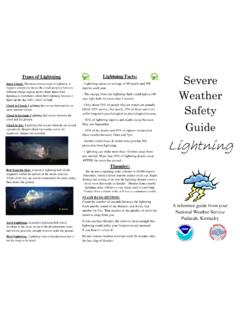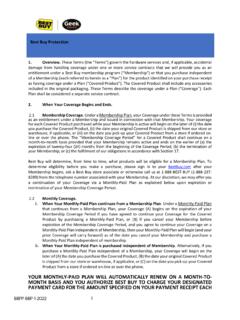Transcription of AC 25.899-1 - Electrical bonding and protection against ...
1 Advisory Circular Subject: Electrical bonding Date: 10/22/07 AC No: AND protection against STATIC Initiated by: ANM-100 ELECTRICITY 1. PURPOSE. This advisory circular (AC) provides guidance for demonstrating compliance with the transport category airplane certification requirements of Electrical bonding and protection against static electricity. 2. APPLICABILITY. a. The guidance provided in this document is directed to airplane manufacturers, modifiers, foreign regulatory authorities, Federal Aviation Administration (FAA) transport airplane type certification engineers, and designees. b. This material is neither mandatory nor regulatory in nature and does not constitute a regulation.
2 It describes acceptable means, but not the only means, for demonstrating compliance with the applicable regulations. We will consider other methods of demonstrating compliance that an applicant may elect to present. While these guidelines are not mandatory, they are derived from extensive FAA and industry experience in determining compliance with the relevant regulations. On the other hand, if we become aware of circumstances that convince us that following this AC would not result in compliance with the applicable regulations, we will not be bound by the terms of this AC, and we may require additional substantiation as a basis for finding compliance.
3 C. This material does not change or create any additional regulatory requirements nor does it authorize changes in or permit deviations from existing regulatory requirements. d. Terms such as shall or must are used in this AC only in the sense of ensuring applicability of this particular method of compliance when the acceptable method of compliance described herein is used. 10/22/07 AC 3. DEFINITIONS. Electrical Wiring Interconnection Systems (EWIS). In part, an EWIS is any wire, wiring device, or combination of these, including termination devices, installed in any area of the airplane for the purpose of transmitting Electrical energy between two or more intended termination points.
4 The complete regulatory definition of an EWIS is in , which is included in Appendix A of this AC. 4. COMPLIANCE GUIDANCE. a. protection against Accumulation of Static charges . (1) General. All items that may cause a danger of Electrical shock, ignition of flammable vapors, or interference with installed Electrical /electronic equipment ( , radio communications and navigational aids) as a result of accumulation and discharge of static charges should be adequately bonded to the main grounding systems. (2) Intermittent contact. The design should ensure that no intermittent contact can occur between metallic and/or metalized parts.
5 (3) High pressure refueling and fuel transfer. High pressure refueling and/or high rates of fuel transfer must not induce dangerously high voltages within the fuel system. Prevention of such an occurrence should be established by test or by consultation with the appropriate fuel and refueling equipment manufacturers. If compliance with this requirement involves any restriction on the types of fuel to be used or on the use of additives, these restrictions should be established. (a) With standard refueling equipment and standard airplane turbine fuels, voltages high enough to cause sparking may be induced between the surface of the fuel and the metal parts of the tank at refueling flow velocities above approximately 7 meters/second (23 feet/second).
6 These induced voltages may be increased by The presence of additives and contaminants ( , anti-corrosion inhibitors, lubricating oil, free water). Splashing or spraying of the fuel in the tank. (b) The static charge can be reduced by 1 adjusting the refueling equipment, such as by increasing the diameter of refueling lines and designing filters to give the minimum of electrostatic charging, or 2 10/22/07 AC 2 changing the Electrical properties of the fuel with anti-static additives, thus reducing accumulation of static charge in the tank to negligible amount, or 3 adjusting the critical refueling rates.
7 Critical refueling rates are related to the airplane refueling installations and the designer should seek the advice of fuel suppliers on this problem. b. bonding Paths. (1) There are two kinds of bonding paths: Primary bonding paths are those paths that are required to carry lightning discharge currents. These paths should be as short as practicable with low Electrical resistance. Secondary bonding paths are those paths provided for other forms of bonding . (2) Primary bonding paths should be used as follows: (a) To connect together the main grounds of separable major components that may carry lightning discharges. (b) To connect engines to the main ground.
8 (c) To connect all metal parts presenting a surface on or outside of the external surface of the airplane to the main ground. (d) To serve as conductors on external non-metallic parts. c. Resistance and Continuity Measurements. Measurements should be made to determine the efficacy of the bonding and connection between at least the following: (1) Primary bonding paths. (a) The extremities of the fixed portions of the airplane and any fixed external panels and components where the method of construction or assembly leads to doubt about the repeatability of the bond (for example, removable panels). (b) The engines and the main airplane ground.
9 (c) External movable metal surfaces or components and the main airplane ground. (d) The bonding conductors of external non-metallic parts and the main airplane ground. 3 10/22/07 AC (e) Internal components for which a primary bond is specified and the main airplane ground. (2) Secondary bonding paths. (a) Metallic parts normally in contact with flammable fluids and the main airplane ground (airplane main structure or ground path). (b) Isolated conducting parts subject to appreciable electrostatic charging and the main airplane ground (airplane main structure or ground path).
10 (c) Electrical panels and other equipment accessible to the occupants of the airplane and the main airplane ground (airplane main structure or ground path). (d) Ground connections that normally carry the main Electrical supply and the main airplane ground (airplane main structure or ground path). The test on these connections should ensure that the connections can carry, without risk of fire or damage to the bond or excessive volt drop, such continuous normal currents and intermittent fault currents as are applicable. (e) Electrical and electronic equipment and the airplane main ground (airplane main structure or ground path), where applicable, and as specified by the airplane manufacturer.


















